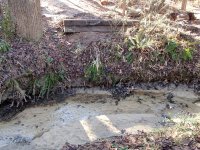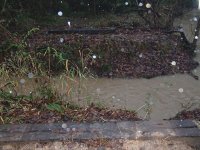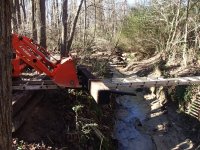Kapnfriday
Bronze Member
I've enjoyed reading all the posts about bridge building on TBN so thought I would share my own. We have a small creek on our property and being able to cross it will allow us access to 3/4 acre that we own but have never used. We'll also be able to walk to a city park. Initially this was just going to be a foot bridge, but then I thought it would be nice to be able to get the tractor over there to clean up/build trails.
The plan is for an 18' span that will be 6-7 feet above the creek bed.

This shot is of the creek at normal water level - not much more than a trickle.

Here's a shot from the opposite bank after we had about 2" of rain over a couple hours.
I have five utility poles that I'm planning to use as the main "beams" across the creek. Initially I was only going to use 3 but I checked with an electrical engineer friend who checked with a structural engineer coworker and they said that would be pushing up against the maximum capacity for my estimated 3,000lb load of the tractor (Kubota B7610) and FEL and any implement I might have on.
The poles are between 10 and 14" in diameter. They will rest on railroad ties pinned to the banks with rebar. Hard to tell in the pictures, but the rail road ties are about 3-4 feet back from the top of the banks. I plan to marry two poles together on both the left and right side of the bridge and strap them together with some kind of cable or other metal strapping. These will be set apart about the distance between my left and right side tractor wheels. The fifth pole will run down the center. I initially thought I'd deck it with pt 2x6's, but now I'm thinking of looking into full dimension 2x6 white oak from a local sawmill.
A couple still undecided things: how to anchor the poles to the railroad ties and the best way to attach the decking to the poles.
The plan is for an 18' span that will be 6-7 feet above the creek bed.

This shot is of the creek at normal water level - not much more than a trickle.

Here's a shot from the opposite bank after we had about 2" of rain over a couple hours.
I have five utility poles that I'm planning to use as the main "beams" across the creek. Initially I was only going to use 3 but I checked with an electrical engineer friend who checked with a structural engineer coworker and they said that would be pushing up against the maximum capacity for my estimated 3,000lb load of the tractor (Kubota B7610) and FEL and any implement I might have on.
The poles are between 10 and 14" in diameter. They will rest on railroad ties pinned to the banks with rebar. Hard to tell in the pictures, but the rail road ties are about 3-4 feet back from the top of the banks. I plan to marry two poles together on both the left and right side of the bridge and strap them together with some kind of cable or other metal strapping. These will be set apart about the distance between my left and right side tractor wheels. The fifth pole will run down the center. I initially thought I'd deck it with pt 2x6's, but now I'm thinking of looking into full dimension 2x6 white oak from a local sawmill.
A couple still undecided things: how to anchor the poles to the railroad ties and the best way to attach the decking to the poles.



